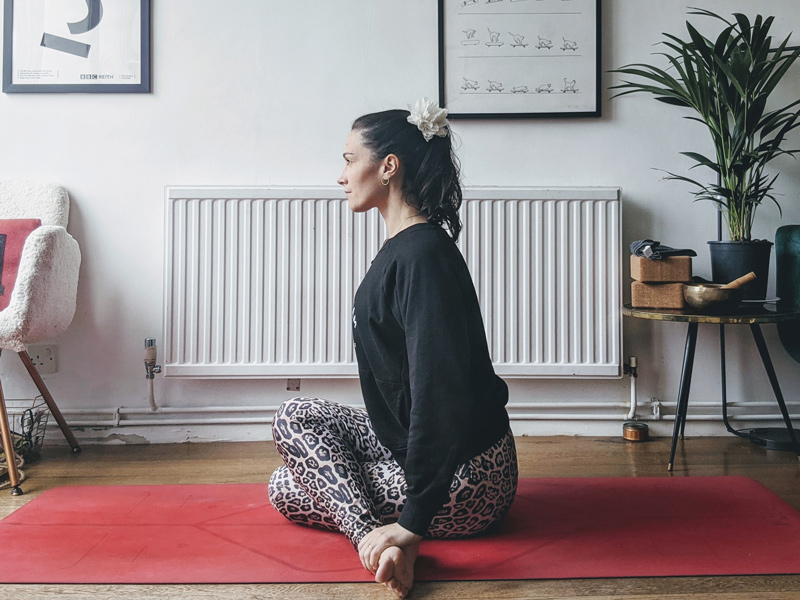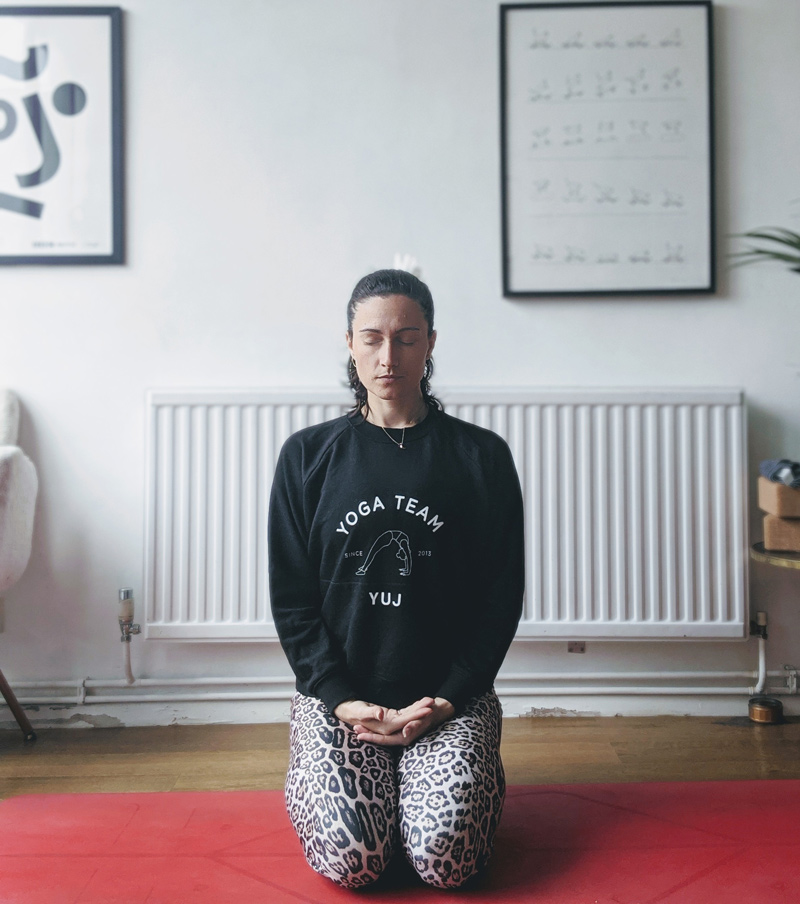Continued Education: Yin yoga
Yin & Yang
It took me a while to understand the benefits and actions of Yin yoga. I am pretty Yang as a person. In yoga, Yin and Yang are the properties of energy. Each person, object, thing, has an energy which can be qualified as both Yin and Yang depending on the context. Yang energy is warm, moving energy, turned outward. Yin energy, on the other hand, is cold energy, still and turned inward. If we compare muscles to the connective tissues of the human body (bones, ligaments and tendons), we can say that the muscles are flexible, moving, and on the surface while the connective tissues are rigid, static and deeper. We can then qualify the muscles as Yang when compared with connective tissues, and the connective tissues as Yin when compared with muscles. These Yin and Yang attributes apply to everything - not only to human body parts - and vary according to what you compare: because everything has both a part of Yin and a part of Yang.

As always in yoga, we seek harmony and balance. When applied to the energy that emanates from a person, we will therefore seek to balance their Yin energy and their Yang energy. Personally, I am obviously very Yang. I'm always on the move, I'm taking up space, I'm making noise. Pretty much the perfect neighbour. Therefore, it's not surprising that initially I've had trouble understanding and practicing Yin yoga. I started to appreciate the benefits of Yin - without necessarily understanding how it works - during my 200h training. No wonder when we spend 3 and a half weeks practicing and studying intensively, that our body finally appreciates these moments of stillness.
Yin yoga benefits
Yin yoga can be practiced for several reasons:
- Physical
- Energetic
- Mental/emotional
It is important to know why we want to practice Yin yoga - what is the intention - as it will affect how we practice, as well as when we choose to practice.
To give you an example, I am hypermobile which means that some of my joints naturally have a greater range of motion than 'normal'. Yin yoga targets the connective tissues and therefore from a physical standpoint, it targets ligaments and tendons (which maintain our joints). One might wonder if it is a good thing for someone like me to practice a type of yoga that aims at making these tissues even more flexible. But if you consider the energetic benefits of Yin yoga, knowing that I am mainly Yang - probably a little too much - Yin yoga helps me to find an energetic balance. To be completely transparent, I personally do not practice Yin yoga for the physical benefits, but more for its energetic, calming and soothing virtues.
Physical benefits
Yin yoga primarily targets the connective tissues. However, the practice will also affect the muscles that are in the way of the targeted areas, but their stress will be passive. With regard to connective tissues, Yin yoga will thicken the ligaments by increasing the production of collagen (collagen is present - in different proportions - in all tissues of the human body). The practice also has an effect on the production of materials that compose cartilage and bone, which helps reduce the degeneration of these tissues. However, if you have osteoporosis, you should seek medical advice before practicing any type of yoga. Yoga can help you improve your bone density, but it should be done in a way that is appropriate for your condition. Last but not least, the practice of Yin yoga will ultimately offer you a greater range of motion, and more flexibility.
Energetic benefits
The practice of Yin yoga will activate our parasympathetic nervous system and thereby improve our ability to react appropriately to situations. This activation will also have the effect of calming the flow of thoughts and ultimately will reduce stress. If you know about Chinese medicine and meridians, the compression of the different parts of the body according to the poses will press on acupressure points, which allows to release the flow of chi (or prana) in the body, and balance it.

Mental and emotional benefits
When you have to stay still for 3 to 8 minutes in an uncomfortable (but not painful) position, you are quickly tempted to try and think of something else. But the yoga practice — whatever type of yoga you're practicing — is a practice of mindfulness. We must try not to let our mind wander in the past - by listing more or less happy memories - or in the future - by listing the things that we still have to do and the shopping list. To stay in the present moment, a simple technique that Alex explained in his article about mindfulness is to count the breaths. It has the effect of calming anxiety and reducing stress. We see things for what they are today, without adding a past or future context that would add drama and prevent us to see the current situation for what it really is. We can then see things more clearly, and calmly choose how we want to react to them.
Practicing Yin yoga
If all these benefits seem to suit your needs, Yin yoga may be a type of yoga that you will enjoy. I would always tend to recommend practicing Yin yoga in addition to a Yang practice (whatever it is), because we should always try to find a balance between the two.
For those of you who are wondering what a Yin yoga class looks like, it usually consists of only a few poses, much less than in a dynamic class, which are usually held for a period of 2 min to 8min. The intensity of a Yin practice is not judged by the intensity of the pose, but by the time that you manage to keep it by staying still.
We can therefore define 3 main principles in the practice of Yin yoga
- Find your edge: you have to know the difference between discomfort and pain. In Yin yoga, we will try and find this limit and hold the pose there
- Stay still: physically and mentally. The two are linked and influence each other.
- Hold the pose: each pose must be held for several minutes in order to create the desired compression / stretching effect. The more rigid connective tissues require more time to soften than the muscles.
60h teacher training with Sampoorna Yoga
I had never attended an online yoga training before and I was not sure what to expect. I can guarantee that once again, Sampoorna has been able to deliver comprehensive and quality training. Despite the difficulties linked to distance, time zones or technology, the Sampoorna teaching team was able to provide an interesting, adapted and easily understandable teaching. If like me you're hesitating because you are not sure to have the necessary attention from the teacher in order to have answers to your questions (if like me you ask a lot of questions), I can you assure you that the written and video material as well as the multiple live sessions will allow you to have all your answers. Of course it is not the same as being there, in India, where we can live all these principles of yogic life as we are taught them, but from a knowledge point of view, this training is both very professional and truly rewarding.
Comments
See all comments →Leave a comment.Fields marked with a * are compulsory. Your email won't be published.
Congratulations! It's such a nice training. It's completely changed my teaching, and even the way I teach vinyasa. My students told me they felt more balanced energetically. Good luck for the test :)

 By Cyrièle
By Cyrièle 
I'm currently doing my 60hr Yin with Sampoorna, absolutely love it :)